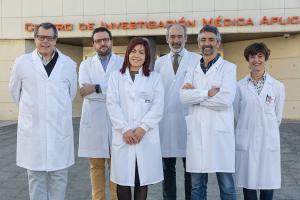
New mechanisms involved in liver regeneration during living donor liver transplantation
Researchers at Cima and Clínica Universidad de Navarra propose that the increase in FGF19 may protect against liver toxicity caused by bile salts
PAMPLONA, NAVARRA, SPAIN, May 7, 2024 /EINPresswire.com/ -- The liver plays a fundamental role in the metabolism of living beings. Specifically, it is the organ that serves as a shield against potential toxic compounds in the diet, or metabolites in the body that must be eliminated. For this reason, the liver has developed an extraordinary regenerative capacity. This process is especially important when partial liver removal is performed on a living donor for transplantation.
Researchers at Cima and the Clínica Universidad de Navarra have identified new mechanisms involved in liver regeneration in humans. "It is known that bile salts are necessary for liver regeneration, but their levels must be carefully controlled to avoid hepatotoxicity. In this study, we propose a possible protective role of a molecule (FGF-19) during early regenerative stages, which is related to the presence of bile salts," explains Dr. Iker Uriarte, a researcher in the Hepatology laboratory at Cima University of Navarra and first author of the paper.
In this study, the scientists selected a group of donors with a higher increase in bile salts than conventional levels. "In this cohort, circulating FGF19 levels were also significantly increased after resection, unlike in the population with a more modest increase in bile salts. This response suggests that FGF19 could play a protective role against toxicity induced by elevated levels of bile salts during liver regeneration," notes Dr. Matías Ávila, director of the Hepatology Laboratory at Cima and co-director of the study, together with Dr. José Ignacio Herrero, a specialist at the Hepatology Unit of the Clínica Universidad de Navarra.
On the other hand, the study highlights that in the group of patients with higher circulating levels of bile salts and FGF19 after resection there is a higher proportion of men than women. "Although more studies are needed to confirm this differential behavior, given the role played by bile salts and FGF19 in liver regeneration, it is interesting to remember that the regenerative response in living donors is faster in men. The results have been published in the specialized journal BBA - Molecular Basis of Disease.
Role in inflammatory liver diseases
The researchers have also analyzed the activity of a key enzyme in bile acid synthesis (CYP7A1) and have shown that it is particularly sensitive to stress and inflammation. "Due to the impact that bile salt synthesis has on hepatic cholesterol levels, our work suggests that the control of CYP7A1 activity and its possible alterations may also play a relevant role in metabolic and inflammatory conditions, such as steatotic liver disease associated with metabolic dysfunction".
The work has been carried out in the framework of the CIBER for Hepatic and Digestive Diseases (CIBERehd) and in close collaboration with Dr. José Juan García Marín and Dr. Mª Jesús Monte, from the University of Salamanca. It has received funding from the Ministry of Science and Innovation, the Spanish Association Against Cancer, the M. Torres Foundation and the Mario Losantos Foundation, among other public and private institutions.
María Pilar Huarte
Cima Universidad de Navarra
+34 948 19 47 00
email us here
Visit us on social media:
Facebook
Twitter
LinkedIn
Instagram
YouTube
EIN Presswire does not exercise editorial control over third-party content provided, uploaded, published, or distributed by users of EIN Presswire. We are a distributor, not a publisher, of 3rd party content. Such content may contain the views, opinions, statements, offers, and other material of the respective users, suppliers, participants, or authors.


